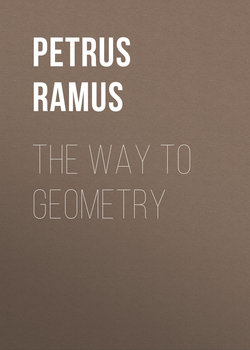The Way To Geometry

Реклама. ООО «ЛитРес», ИНН: 7719571260.
Оглавление
Petrus Ramus. The Way To Geometry
TO THE. WORSHIPFVL
The Authors Preface
THE FIRST BOOKE OF Peter Ramus's Geometry, Which is of a Magnitude
The second Booke of Geometry. Of a Line
The third Booke of Geometry. Of an Angle
The fourth Booke, which is of a Figure
The fifth Booke, of Ramus his Geometry, which is of Lines and Angles in a plaine Surface
Of Geometry, the sixt Booke, of a Triangle
Of Geometry, the seventh Booke, Of the comparison of Triangles
Of Geometry the eight Booke, of the diverse kindes of Triangles
The ninth Booke, of P. Ramus Geometry, which intreateth of the measuring of right lines by like right-angled triangles
The tenth Booke of Geometry, of a Triangulate and Parallelogramme
Of Geometry, the eleventh Booke, of a Right angle
Of Geometry the twelfth Booke, Of a Quadrate
Of Geometry, the thirteenth Booke, Of an Oblong
The fourteenth Booke, of P. Ramus Geometry: Of a right line proportionally cut: And of other Quadrangles, and Multangels
The fifteenth Booke of Geometry, Of the Lines in a Circle
The sixteenth Booke of Geometry, Of the Segments of a Circle
Of Geometry the seventeenth Booke, Of the Adscription of a Circle and Triangle
Of Geometry, the eighteenth Booke, Of the adscription of a Triangulate
Of Geometry the ninteenth Booke; Of the Measuring of ordinate Multangle and of a Circle
Of Geometry the twentieth Booke, Of a Bossed surface
Geometry, the one and twentieth Book, Of Lines and Surfaces in solids
The twenty second Booke, of P. Ramus Geometry, Of a Pyramis
The twenty third Booke of Geometry, of a Prisma
Of Geometry the twentie fourth Book. Of a Cube
Of Geometry the twenty fifth Booke; Of mingled ordinate Polyedra's
Of Geometry the twenty sixth Booke; Of a Spheare
Of Geometry the twenty seventh Book; Of the Cone and Cylinder
Отрывок из книги
Two things, I feare me, will here be objected against me: The one concerneth my selfe, directly: The other mine Author, and the worke I have taken in hand the translating of him. Concerning my selfe, I suppose, some will aske, Why I being a Divine; should meddle or busie my selfe with these prophane studies? Geometry may no way further Divinity, and therefore is no fit study for a Divine? This objection seemeth to smell of Brownisme, that is, of a ranke peevish humour overflowing the stomach of some, whereby they are caused to loath all manner of solid learning, yea of true Divinity it selfe, and therefore it doth not deserve an answer: And this we in our Title before signified. For we have not taken this paines for Turkes and others, who by the lawes of their profession are bound to abandon all manner of learning. But if any man shall propose it, as a question, with a desire of satisfaction, we are ready to answer him to the best of our abilitie. First, that Theologia vera est ars artium & scientia scientiarum, Divinity is the Art of Arts, and Science of Sciences; or Divinity is the Mistresse upon which all Arts and Sciences are to attend as servants and handmaides. And why then not Geometry? But in what place she should follow her, I dare not say: For I am no herald, and therefore I meddle not with precedencie: But if I were, she should be none of the hindermost of her traine.
The Oratour saith, and very truly doubtlesse, That, Omnes artes, quæ ad humanitatē pertinent, habent commune quoddam vinculum, & cognatione quadam inter se continentur. All Arts which pertaine unto humanity, they have a certaine common bond, and are knit together by a kinde of affinity. If then any Arts and Sciences may be thought necessary attendants upon this great Lady; Then surely Geometry amongst the rest must needes be one: For otherwise her traine will be but loose and shattered.
.....
This definition of it selfe is somewhat obscure, and to be understand onely in a geometricall sense: And it dependeth especially of the common bounde. For the parts (which here are so called) are nothing in the whole, but in a potentia or powre: Neither indeede may the whole magnitude bee conceived, but as it is compact of his parts, which notwithstanding wee may in all places assume or take as conteined and continued with a common bound, which Aristotle nameth a Common limit; but Euclide a Common section, as in a line, is a Point, in a surface, a Line: in a body, a Surface.
5. A bound is the outmost of a Magnitude.
.....